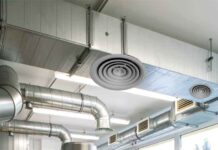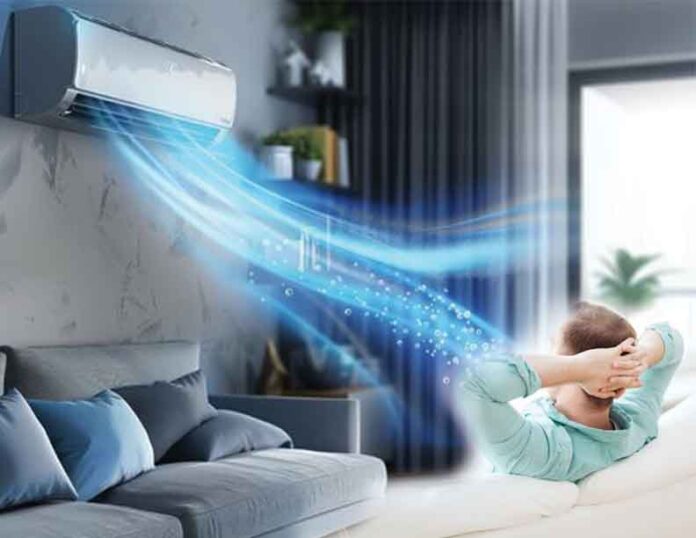
The issue of indoor air quality in air-conditioned spaces is a complex matter that requires a multi-faceted approach. The conventional wisdom is that running a room Air Conditioner (AC) with doors and windows closed is the most effective way to maintain a comfortable temperature. The prevalent absence of adequate ventilation system is often observed in workspaces like individual office cabins, porta cabins, residential structures including bungalows and villas, as well as small commercial establishments.
These spaces typically rely on the utilisation of window air-conditioners and wall-mounted split air-conditioners that are typically devoid of an integrated mechanism that ensures a persistent influx of fresh outdoor air.
This approach can have unintended consequences on Indoor Air Quality (IAQ), leading to the phenomenon known as Sick Building Syndrome (SBS). SBS is a condition characterised by a range of health problems, including headaches, respiratory issues, and fatigue, which are often linked to poor indoor air quality. This is particularly concerning in areas with high humidity, such as tropical regions, where the risk of mold growth and bacterial proliferation is increased. In these environments, maintaining a healthy indoor air quality becomes a top priority.
A wrong belief
One common misconception about running an air conditioner is that keeping doors and windows open can lead to a significant loss of cooling energy, resulting in higher electricity bills and decreased system efficiency.
While it is partially true that this practice can negate the benefits of air conditioning, it also provides a constant supply of fresh air inside the air-conditioned room, helping to dilute contaminated and stagnant air.
In most residential or commercial buildings, where window air-conditioners and wall mounted split air-conditioners are predominantly used, the doors and windows of the rooms are kept closed while the AC is operating to maximise cooling efficiency. However, this approach can negatively impact the IAQ.
When the AC runs with the doors and windows closed, the stale air circulates throughout the room, leading to a buildup of pollutants and airborne pathogens. This can cause a range of health problems, from mild discomfort to severe respiratory issues. As we continue to address the complexities of indoor air quality, it is essential to explore innovative methods that make a real difference in our lives.
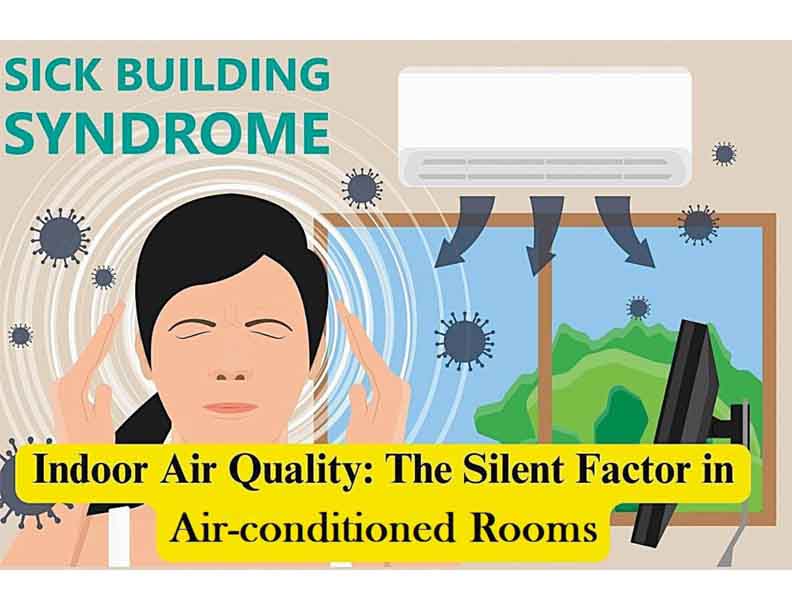
Impact of lack of ventilation in air-conditioned rooms
In recent years, there has been an increasing interest in finding innovative methods to improve indoor air quality in air-conditioned spaces. Among the various effective methods that have been demonstrated, this article discusses three specific approaches. These methods have been rigorously tested and proven to be suitable for implementation in residential and commercial offices and buildings that primarily use window air conditioners and wall mounted split air conditioner units. All these three methods are straightforward and cost-effective; however, their effectiveness is limited to specific room layouts that accommodate them.
Method – 1
The first method in the list consists of a combination of two small ventilation fans equipped with gravity louvers. One of these fans function to pump in fresh outdoor air while the other one functions to vent out the contaminated air from the closed air-conditioned room.
This system is designed to maintain a healthy balance between indoor air quality and cooling efficiency. The basic principle behind this system is to create a controlled ventilation cycle that allows for the exchange of stale air with fresh air.
By providing two small ventilation fans each coupled to gravity louvers in the room, it is possible to create a continuous cycle of air exchange. The fans are programmed to operate only during the compressor off-cycles, which typically occur intermittently, depending on the setpoint temperature on the thermostat. As the fans begin to operate, they create a ventilated condition in the room, that withdraws the stale air out of the room and concurrently allows a controlled quantity of fresh air to enter the room.
At the same time, the gravity louvers open to allow the flow of air across the room during operation cycle of the fan. As soon as the fans stop operating, the gravity louvers are automatically closed by gravity, ensuring that neither the fresh air is allowed back into the room, nor the cool air will be vented out of the room.
The supporting automation system plays a crucial role in ensuring that the fans operate only during the compressor off-cycles. This is achieved by triggering the fans to turn on and off in synchronisation with the compressor’s operation.
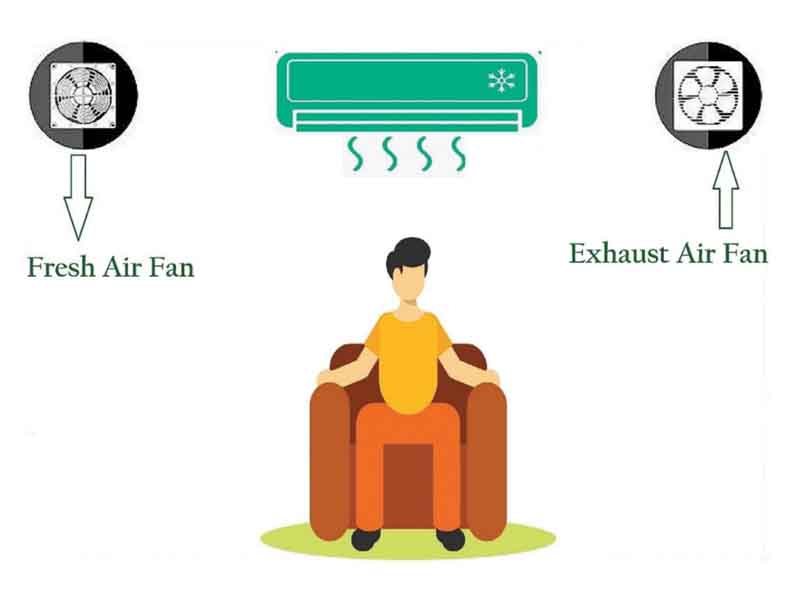
Advantages
One of the key advantages of this system is its ability to maintain a healthy indoor air quality without disrupting the indoor climatic conditions. By allowing a controlled exchange of stale air with fresh air, it is possible to reduce the risk of Sick Building Syndrome and promote a healthier living or working environment. But the limitation of this system is that it works only for non-inverter compressors that functions on cut-in & cut-off cycles upon maintaining set temperature in the air-conditioned room.
This innovative method offers a practical and effective way to address the issue of indoor air quality in air-conditioned spaces. By promoting a continuous cycle of air exchange, it is possible to reduce the risk of Sick Building Syndrome and promote a healthier living or working environment. Incorporating this method into our daily lives can have a significant impact on our health and productivity.
With the advent of latest technologies in air-conditioning, all the modern air-conditioners are integrated with inverter compressors that function on varying thermal load patterns in the air-conditioned room and very rarely cuts-off. For such air-conditioners that consists of inverter compressors, the NOT gate principle of ventilation fan operation won’t work effectively. As we advance in this article, there are other solutions that suits for inverter compressor equipped air-conditioners.
Method – 2
Another alternative method to the ventilation optimisation is the strategic placement of a dedicated fresh air fan coupled with air-filter and gravity louver, to draw in clean, outdoor air into the interior space. Additionally, installing a gravity louver on the
opposing wall completes the overall design of the ventilation setup.
The precision of this ventilation system relies on incorporating an automated network of CO2 sensors that are strategically positioned at different corners of the air-conditioned rooms to continuously monitor and detect fluctuations in carbon dioxide concentration within the indoor environment. Upon identifying variations in CO2 levels, they transmit the real-time data to a sophisticated central control unit that is programmed to manage the operation of the ventilation fan, thus initiating its function when necessary to maintain an optimal air quality standard.
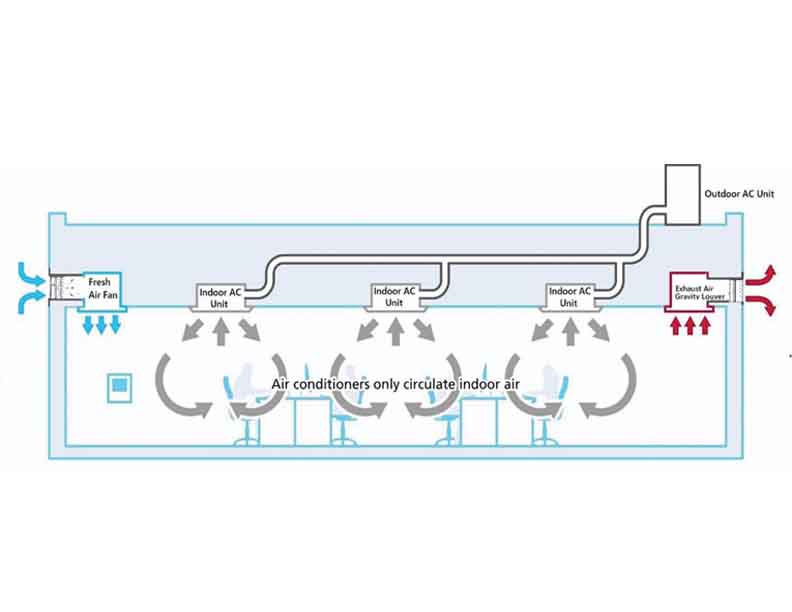
Advantages
The intelligent controller makes informed decisions about when to trigger the fan operation for maintaining an optimal level of freshness and air quality within the rooms. By doing so, the system operates in intermittent cycles, ensuring that the ventilation process is not only highly efficient but also provides a more comfortable and healthier environment for the occupants. Whenever the internal pressure increases, typically when the air-conditioning unit is in operation and the room is sealed, this set-up allows the contaminated or stale air accumulated indoors naturally expel from the room.
The operation of this fresh air fan can be controlled by sensing either the room temperature or else the CO2 levels, ensuring that a consistent flow of fresh air is introduced into the room to prevent the buildup of stale or contaminated air. The provision of air-filter at the fresh air fan inlet is essential for restricting the entry of pollutants, allergens, and other unwanted particles through the outdoor fresh air that may affect the health and comfort of the occupants.
The benefits of this system are numerous, and its implementation can have a significant impact on the health and well-being of occupants. In addition to the health benefits, this system also contributes to a more sustainable and energy-efficient approach to air conditioning. By adding fresh air to the air-conditioned spaces intermittently, the cooling losses can be minimised to a greater extent and whatever the minor losses that occur can be compensated by the healthy environment that otherwise would create a sick environment thereby resulting in loss of productivity and regular illness of the occupants.
Furthermore, the design of this ventilation system is flexible and can be easily adapted to suit different requirements or preferences by configuring the system to operate in a vice-versa manner. This means that the exhaust air fan can be installed, for pulling in air from the louver rather than pushing it through fresh air fan. The installation of such ventilation system not only enhances the comfort of the space by regulating the temperature and air quality, but it also plays a crucial role in maintaining a healthy and safe environment.
Method – 3
Introducing a ventilation system into an air-conditioned environment can be accomplished through another unique method that involves providing a wall opening equipped with an air-filter and a gravity louver. This air-filter allows fresh and uncontaminated air to flow from the external environment into the indoor air-conditioned space. It ensures that the incoming air is clean and free from pollutants, thereby enhancing the overall air quality within the room.
To facilitate the escape of contaminated air that may accumulate in the air-conditioned room, a door louver should be installed in the washroom attached to that space. The effectiveness of this system largely depends on the negative pressure created by the exhaust fan installed on the washroom wall. As fresh air enters, it circulates and mixes with the existing conditioned air, effectively diluting the concentration of contaminated air that may have built up.
The exhaust fan generates negative pressure, helping in drawing the contaminated air through the static louver provided on the washroom door. The strategic placement of the exhaust fan and door louver, is crucial for the functionality of this ventilation strategy.
Advantages
This system effectively maintains the conditions and air quality in both the air-conditioned area and the washroom. This method is effective for rooms with an attached washroom facility. By ensuring that the air circulating within the air-conditioned space remains as clean and pure as possible, the system reduces the risk of health issues arising from prolonged exposure to poor air quality.
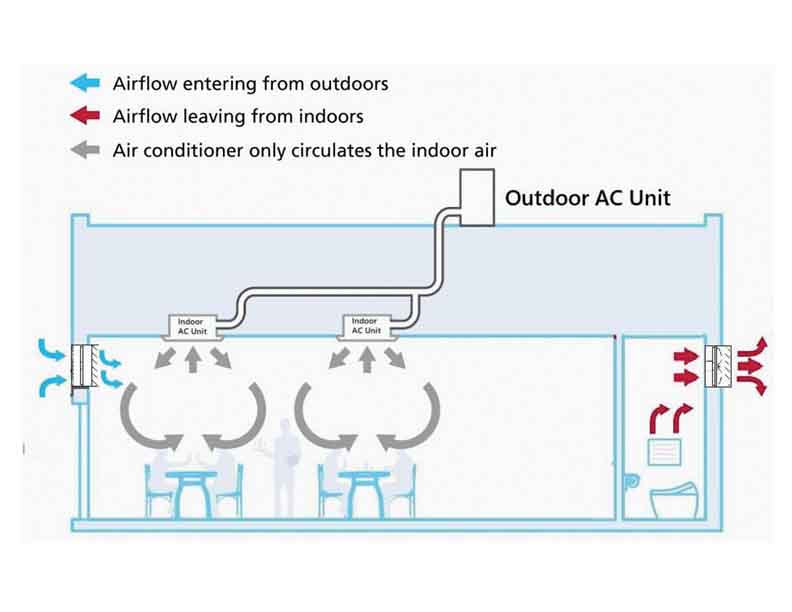
An important note
While implementing a controlled ventilation system within a conditioned environment represents an effective solution to address Indoor Air Quality (IAQ) concerns for air-conditioning users and consumers, it also introduces certain challenges.
A substantial number of these individuals are not specialised in this domain – and thus may be uninformed regarding the precise sizing of fans or the intricate process of calculating the necessary airflow rates. Also, in certain geographies where the ambient conditions are humid, condensation problems arise due to introduction of outdoor air in an air-conditioned space. Consequently, the intervention of a professional consultant becomes imperative to ensure the meticulous design and implementation of such a ventilation system.
Conclusion
In conclusion, an air-conditioned room equipped with an effective ventilation presents a practical and effective solution to the issue of indoor air quality. By implementing this system in a space with window or split air conditioners, a healthier living and working environment can be created, significantly reducing the risk of health problems.
The air quality in an air-conditioned environment can be greatly improved by incorporating an optimised ventilation system. This combination of advanced technology and thoughtful engineering ensures that the room remains pleasant and conducive to health for all occupants. Optimising the ventilation system with a fresh air / exhaust air fan and gravity louver is a valuable modification that can enhance overall air quality and comfort within the space.

S. Rao holds a degree in Mechanical Engineering and has penned several technical books. With a rich background of 27 years in the HVAC field, he has worked both in India and abroad, notably in Bahrain. He has been designated as a Certified Energy Manager by the Bureau of Energy Efficiency and also qualified as a Certified Engineering Professional by ISHRAE. In addition to his professional engagements, Rao has imparted his knowledge and insights through numerous distinguished lectures to various chapters of ISHRAE and AEE western region focusing on HVAC systems & energy conservation strategies.



